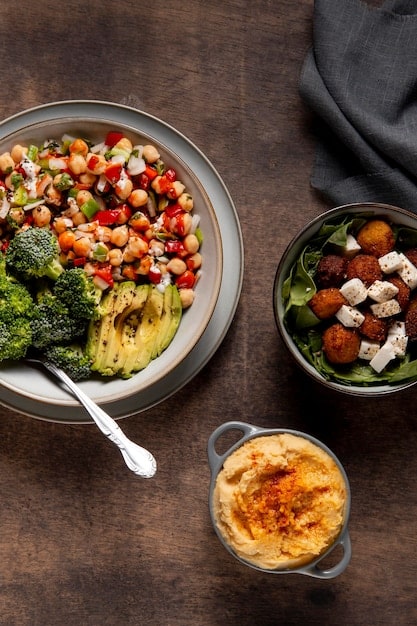Reduce Sodium by 25% in Your Comfort Food by 2025

Reducing sodium intake by 25% in your favorite comfort food recipes by 2025 involves practical strategies like using herbs and spices, choosing low-sodium alternatives, and adjusting portion sizes to promote healthier eating habits.
Craving comfort food but worried about sodium? Learn how to reduce sodium by 25% in your favorite comfort food recipes by 2025 without sacrificing flavor. Let’s make healthier versions of the classics!
Understanding the Sodium Problem in Comfort Food
Comfort foods are often high in sodium due to processing and seasoning. This high sodium content can contribute to health issues, making it crucial to find ways to reduce it.
Let’s explore why reducing sodium is so important and how it impacts our health.
Why is Sodium a Concern?
Excessive sodium intake is linked to several health problems. Understanding these risks can motivate us to make healthier choices.
Health Risks of High Sodium Intake
Consuming too much sodium can lead to serious health issues. Here are some key concerns:
- High Blood Pressure: Sodium increases blood volume, which raises blood pressure.
- Heart Disease: Elevated blood pressure can strain the heart, increasing the risk of heart disease.
- Stroke: High sodium contributes to strokes by damaging blood vessels.
- Kidney Problems: The kidneys have to work harder to filter excess sodium, potentially leading to kidney damage.
By understanding these risks, we can appreciate the importance of reducing sodium in our diets.
Reducing sodium doesn’t mean giving up your favorite meals. It’s about making smart substitutions and adjustments to enjoy healthier versions of comfort food classics.
Simple Swaps for Big Sodium Savings
Making small changes can lead to significant reductions in sodium. Swapping high-sodium ingredients for low-sodium alternatives is a great place to start.
Here are some of the easiest ingredient swaps you can make:

Smart Ingredient Substitutions
Switching out a few key ingredients can dramatically lower the sodium content of your meals.
- Fresh Herbs and Spices: Use fresh herbs and spices instead of salt to flavor your dishes.
- Low-Sodium Broth: Opt for low-sodium or no-salt-added broth in soups and stews.
- Unsalted Butter: Choose unsalted butter or margarine over salted varieties.
- Low-Sodium Soy Sauce: Use low-sodium soy sauce or tamari to reduce sodium in Asian-inspired recipes.
These simple substitutions can make a big difference in your overall sodium intake.
By being mindful of ingredient choices, you can enjoy your favorite meals without the added health risks.
Flavor-Boosting Techniques Without Salt
Enhancing flavor without relying on salt is an art. Experimenting with different herbs, spices, and cooking methods can create delicious, low-sodium dishes.
Let’s look at some techniques you can use.
Herbs and Spices: Your New Best Friends
Herbs and spices can add depth and complexity to your dishes, making them more flavorful without the need for salt.
Creative Culinary Techniques
Here are some ways to use herbs and spices effectively:
- Garlic and Onion: Sauté garlic and onion to create a flavorful base for soups and sauces.
- Citrus Zest: Add citrus zest (lemon, lime, or orange) for a bright, zesty flavor.
- Vinegar: Use vinegar (balsamic, apple cider, or red wine) to add tanginess and acidity.
- Chili Peppers: Incorporate chili peppers (fresh or dried) for a spicy kick.
These techniques can transform your dishes and make you forget all about salt.
Embrace these flavor-boosting techniques to create dishes that are both delicious and good for you.
Revisiting Classic Comfort Food Recipes
Adapting classic comfort food recipes to reduce sodium is easier than you might think. Let’s look at some specific examples.
Here’s how you can modify some popular recipes:
Mac and Cheese Makeover
Mac and cheese is a beloved comfort food, but it’s often loaded with sodium. Here’s how to make it healthier:
Use low-sodium cheese and milk. Add spices like nutmeg and black pepper for flavor. Top with breadcrumbs seasoned with herbs instead of salt.
Soup Sensibly
Soups can be high in sodium due to bouillon cubes and canned ingredients. Use low-sodium broth. Add fresh vegetables and herbs for flavor. Avoid adding extra salt.
Shepherd’s Pie with Less Salt
Shepherd’s pie can be made healthier by using lean ground meat, low-sodium broth, and plenty of vegetables. Season with herbs instead of salt.
These modifications can help you enjoy your favorite comfort foods without compromising your health.

Planning Your Low-Sodium Comfort Food Menu
Creating a low-sodium menu involves careful planning and attention to detail. It’s about making informed choices to reduce sodium intake while still enjoying delicious meals.
Let’s dive into how you can plan your menu effectively.
Tips for Planning a Low-Sodium Menu
Here are some essential tips to help you create a low-sodium menu:
- Read Labels Carefully: Always check nutrition labels to monitor sodium content in packaged foods.
- Cook at Home: Preparing meals at home allows you to control the ingredients and sodium levels.
- Plan Ahead: Write out your menu for the week to ensure a balanced and low-sodium diet.
- Limit Processed Foods: Reduce consumption of processed foods, which are typically high in sodium.
By following these guidelines, you can create a menu that supports your health goals.
Remember, with a little planning, you can enjoy a variety of delicious, low-sodium comfort foods.
Long-Term Strategies for Sodium Reduction by 2025
Achieving a 25% reduction in sodium intake by 2025 requires a long-term commitment and sustained effort. It involves changing habits, educating yourself, and staying motivated.
Here are some strategies to help you stay on track:
Making Lasting Changes
Focus on adopting habits that will support your goal over the long term.
Sustained Efforts for Success
Consider these practices:
- Educate Yourself: Learn about sodium content in different foods and the impact on your health.
- Set Realistic Goals: Start with small, achievable steps to avoid feeling overwhelmed.
- Track Your Progress: Keep a food diary to monitor your sodium intake and identify areas for improvement.
- Seek Support: Join a support group or work with a dietitian to stay motivated and accountable.
With persistence and dedication, you can meet your sodium reduction goals.
The effort is well worth it for the sake of your health and well-being.
| Key Point | Brief Description |
|---|---|
| 🧂 Sodium Awareness | Understand the risks of high sodium intake. |
| 🌿 Flavor Enhancement | Use herbs and spices instead of salt. |
| 🔄 Ingredient Swaps | Opt for low-sodium alternatives. |
| 🍽️ Portion Control | Manage sodium by controlling portion sizes. |
Frequently Asked Questions
▼
High sodium intake can lead to high blood pressure, heart disease, stroke, and kidney problems. Reducing sodium helps mitigate these risks and promotes overall health.
▼
Use fresh herbs, spices, garlic, onion, citrus zest, vinegar, and chili peppers to boost flavor. These alternatives add depth and complexity to your dishes without the need for salt.
▼
Swap regular broth for low-sodium broth, salted butter for unsalted butter, and regular soy sauce for low-sodium soy sauce. These small changes make a big difference.
▼
Use low-sodium ingredients in mac and cheese, soups, and shepherd’s pie. Season with herbs and spices instead of salt, and be mindful of portion sizes to control sodium levels.
▼
Educate yourself about sodium content, set realistic goals, track your progress, and seek support. Making lasting changes requires a commitment to these strategies for sustained success.
Conclusion
Reducing sodium in your comfort food recipes by 25% by 2025 is an achievable goal with the right strategies. By understanding the risks of high sodium, using flavor-boosting techniques, and making smart ingredient swaps, you can enjoy healthier and equally delicious versions of your favorite meals. Embrace these tips, and take control of your health while still savoring the comfort foods you love.





